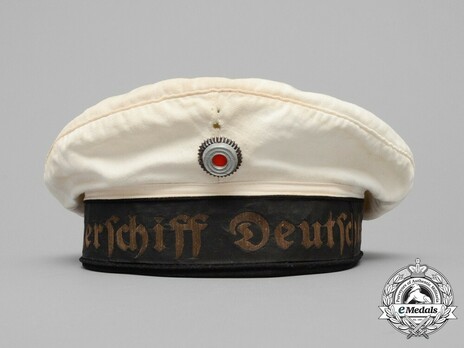Kriegsmarine White Sailor's Cap
CATEGORY: Version
SKU: 21.GOR.01.03.02.002.000
Estimated market value:




Estimated market value:
Cap in white cotton, exterior of the reinforced sidewall in a black felt, a tally ribbon in black rayon wrapped around the edge and inscribed "Panzerschiff Deutschland" in gold-coloured threading, the tally ribbon held in place by three black vertical stands of twisted cord, one on either side and one at the rear, the two ends of the tally ribbon dangling from the rear, two reinforced holes sewn in place in a vertical pattern on the peak, the top hole designed for a Kriegsmarine eagle that has since been lost to time, the bottom hole housing a tri-colour cockade with a painted black base incorporating a silvered ring and red felt centre, the rear with two holes initiated on either side of the seam, the wide sweatband with a very smooth black synthetic upper, the edge butting the opening trimmed in black and white rayon, the sweatband with a black rayon underside, while the undersides of the sidewall are lined in salmon-coloured cotton mesh, the cap measuring 245 mm x 260 mm x 50 mm in height, exhibiting soiling on top, along with slight separation of the stitching of the sweatband from the sidewall at the right rear. Very fine.
The headgear and uniforms worn by members of the Kriegsmarine were based upon the designs utilized by the Kaiserliche Marine and the Reichsmarine. The official regulations governing the uniforms of the Reichsmarine were issued on April 5, 1921, and they were embraced, with a few alterations, as the Kriegsmarine uniforms in 1935. New guidelines concerning rank insignia were issued in 1936.
The Cap was primarily worn by Kriegsmarine personnel who held the rank of Junior Non-Commissioned Officer or Private. It was also worn by Kriegsmarine Cadets during the Second World War.
It is composed of several main elements, including the cloth top cover and piping, the navy blue cap band with piping, the cap band tally (mützenbänder), the interior lining, the diamond-shaped moisture shield, the brown leather sweat band, and the manufacturer’s logo and associated information. Each cap was also adorned with a tricolour cockade and a national emblem.
In 1926, caps with a removable top cover were introduced. These caps had an additional layer of white gauze added to the top of the cloth lining. This form of cap allowed the personnel to switch between a navy blue top cover and a white top cover. The navy blue top cover was utilized for general wear, while the white top cover was only meant to be worn in tropical climates; this regulation was largely ignored. The caps with a permanent top cover were often manufactured privately.
In 1919, the cap band tallies (mützenband) featured the name of the unit or ship of the wearer in Latin lettering. In 1929, the lettering used on the tallies was changed to Gothic. Initially, all numbers were written in the Roman style, but they were changed to the Arabic style in 1935. Lastly, in 1938, a standardized tally policy was introduced wherein “KRIEGSMARINE” was the only lettering featured on the tally. In September 1939, all other peacetime tally variations were removed from circulation. These tallies were generally composed of silk, and the gold-coloured letters were machine embroidered with rayon, cotton, and artificial silk thread; gilt thread quickly oxidized as a result of the sea air.
This cap was also known as the Enlisted Men's Cap, the Service Cap (Dienstmütze), the Cloth Cap (Tuchmütze), and unofficially as the Donald Duck Cap.

Comments
Sign in to comment and reply.


Scroll Top